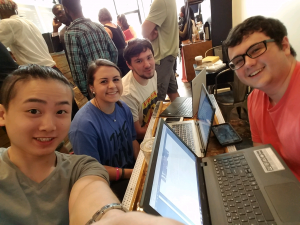Should we include pictures of the buildings in our project or just descriptions?
Annotated Bibliography 4
Annotated Bibliography 3
This article discusses the negatives of gentrification as well as the positives. As more people come to the area, it becomes more likely to be gentrified, however with more people comes more money, as well as an improved police force, fire department, and economy for the area. This article provides good arguments both for and against gentrification, however the arguments hardly scrape the surface of the subject and could be more in depth. This article is important as it provides insight to both sides of the argument over gentrification. The reason this source was chosen is because, unlike other articles, it provides insight into both arguments against and for gentrification, which is necessary in order to provide a rebuttal in an argument. The main points to be taken from this article is that while gentrification is good in terms of bringing safer infrastructure and safety departments, it also brings the negative change of making people lose homes and, in turn, their way of living.
Annotated Bibliography 2
Annotated Bibliography 1
What makes a good annotation?
Asks a question
Thorough analysis of text
Makes a connection to other literature or classes
Deeper understanding of text, reads between the lines
Analyzes arguments
Easy to understand
Provides insight into the true meaning of text
Takes other perspectives into account
An explanation
Leave your opinion out
Civic Center Walk Map
http://arcg.is/2bFyYrB
This was a very neat walk that included stops at places such as the Atlanta Civic Center as well as the Marriott Marquis.
Study Group
Syllabus Quiz
Instructions: Copy and past these questions into a new blog post on your sites.gsu.edu WordPress site. Answer the questions, and when you’re done, submit the link to your new post using the submission form.
Questions:
What are the major projects? In a bulleted list, provide links to the project descriptions for each of them.
- Reading Annotations (http://atlspaceplacerhetf16.robinwharton.net/syllabus-course-info/#ProjectsRow1)
- Annotated Bibliography (http://atlspaceplacerhetf16.robinwharton.net/syllabus-course-info/#ProjectsRow1)
- Built Environment Descriptions (http://atlspaceplacerhetf16.robinwharton.net/syllabus-course-info/#ProjectsRow2)
- Built Environment Analysis (http://atlspaceplacerhetf16.robinwharton.net/syllabus-course-info/#ProjectsRow2)
How will your final grade be calculated?
- Reading Annotations (3, 300-600 points)
- Annotated Bibliography (10 entries): 250-500 points
- Built Environment Descriptions (3, 1 each for exterior, interior, digital space): 300-600 points
- Built Environment Analysis (1): 300-600 points
- Participation (including attendance): 400-???
The final grade will be C for 1675 points, B for 2400 Points, and A for 2800 Points
What is the “submission form” and how do you use it? Embed the form below your answer (hint: Google “embed Google form” to find out how).
Embed the course calendar and weekly overview below this question.
Where on the course website can you find an overview of what’s due and the readings for each unit?
Under the Calender Tab.
What is the best way to see an overview of what’s due each week?
Under “Weekly Overview” under the calendar tab.
What is the attendance policy?
You lose 10 points for every missed class, and gain 10 for showing up to class.
What are the two ways you can lose points?
Missing class and failing to turn in projects.
What are my office hours, and how do you make an appointment to see me outside of class?
Tuesday/Thursday 9-11 AM, email rwharton3@gsu.edu
How do you earn participation credit? Provide a link to the instructions/guidelines for participation.
Points will be assigned based on in-class participation. (http://atlspaceplacerhetf16.robinwharton.net/syllabus-course-info/#ProjectsRow3)
How many points can you earn by participating in or organizing a study group session?
Up to 25
How can you be assured of earning an “A” in this course?
Complete all major projects, miss no more than 4 class meetings, and get at least 2,800 points.
What are the minimum requirements for earning a passing grade of “C”?
Complete all major projects, come to class prepared, and miss only four class meetings.
What do you do if you’re not sure how to document your participation in order to earn points?
Complete a Submission form or Email the teacher.
What are the Unit 1 readings and which one would you like to annotate for Reading Annotation 1?
“Introduction” by Carter and Cromley, “Parting Ways” by Deetz, and “The Cultural Work of a Mohegan Painted Basket” by Fitzgerald. I will annotate whatever is assigned to group 1.
Hello world!
Welcome to your brand new blog at sites@gsu.edu!
To get started, edit or delete this post and check out all the other options available to you.
For assistance, visit the comprehensive support site, check out the Edublogs User Guide guide or stop by The Edublogs Forums to chat with other edubloggers.
For personal support, you can attend Georgia State’s training on Edublogs or stop by The Exchange for one-on-one support.
You can also reference the free publication, The Edublogger, which is jammed with helpful tips, ideas and more.

